Optical Glass Market Research, 2032
The global optical glass market size was valued at $1.2 billion in 2022, and is projected to reach $2 billion by 2032, growing at a CAGR of 5.7% from 2023 to 2032. Optical glass is a specialized type of glass designed and manufactured for optical applications, characterized by its specific optical houses and high clarity. Optical glass is designed to minimize the amount of absorption by using impurities. The presence of micron-sized foreign particles within the glass can scatter incoming light rays, thereby reducing the overall transparency of the glass. Some types of optical glass utilize absorption and scattering with the assistance of additives and impurities.
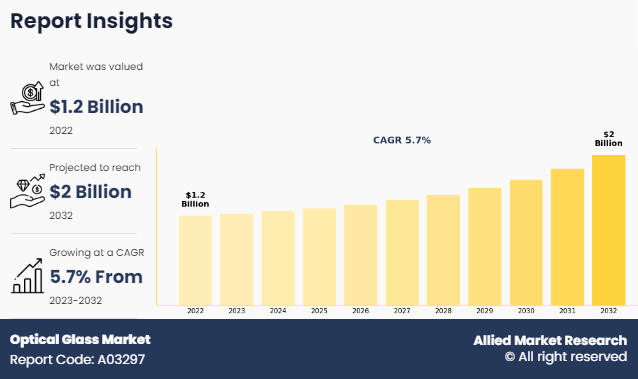
Optical glass is a suitable thermal insulator, allowing technologies for developing future scientific devices, instruments, and techniques for diagnostic therapy and surgical uses. The optical industry is projected to develop exponentially due to demand from hospitals, clinics, and clinical facilities. Therefore, the market is anticipated to see an increase in technological advancements, key mergers & acquisitions, and collaborations in developing regions. Various industries depend on optical glass for a wide range of applications, consisting of telecommunications, aerospace, defense, healthcare, automotive, and client electronics. The increasing demand for magnificent imaging, unique measurement, and superior optical structures in these industries boosts the demand for optical glasses.
The healthcare industry is witnessing an increase in demand for advanced scientific imaging devices such as endoscopes, ultrasound system and optical coherence tomography (OCT) system. Optical glass is an essential thing in these devices, as it enables high-resolution imaging and correct diagnostics. The electronic industry relies on optical glass for a variety of applications, which include optical sensors, displays, and fiber optics verbal exchange systems. The proliferation of smartphone, tablets, and others electronic devices drive the demand for optical glass in these sectors. All these factors are anticipated to drive the optical glass market growth during the forecast period.
Optical glass formulations often require specific raw materials with particular chemical compositions to achieve preferred optical properties such as refractive index, dispersion, and transmission characteristics. If these raw materials are scarce or challenging to obtain, it can constrain the production of certain types of optical glass, limiting the range of products available in the market. Raw materials for optical glass manufacturing can also be obtained from various sources worldwide. Any disruptions in the supply chain, such as natural disasters, geopolitical tensions, alternate restrictions, or transportation issues, can lead to shortages or delays in acquiring essential raw materials. Such disruptions can disturb production schedules, increase costs, and have an effect on the availability of optical glass products in the market.
Nanotechnology enables the precise engineering of optical materials at the nanoscale, providing unprecedented control over their optical properties. This level of control allows for tailored manipulation of light-matter interactions, leading to advancements in various fields such as photonics, optoelectronics, and sensing technologies. By manipulating the size, shape, and association of nanoparticles inside the glass matrix, researchers can tailor the refractive index, dispersion, and other optical traits of the material. This capability opens up new probabilities for designing and manufacturing superior optical glass with increased performance and functionality.
In addition, optical glass plays a vital role in medical imaging devices, diagnostic instruments, and biophotonics applications. Advancements in optical glass technology enable the development of high-resolution imaging systems, minimally invasive surgical tools, and diagnostic devices for healthcare professionals, driving innovation in medical diagnostics and treatments.
The key players profiled in this report include Schott, Hoya, Ohara Corporation, Edmund Optics, Crystran Ltd., Sterling Precision Optics, Sumita Optical Glass, CDGM Glass Company, Nikon Corporation, and Carl Zeiss. Investment and agreement are common strategies followed by major market players. For instance, in August 2021, Edmund Optics expanded its South Korea workplace in response to customer demand. The agency announced the relocation of its regional South Korea workplace to a larger facility in the Mapo district of Seoul. This expansion, in the most significant metropolitan areas, is essential to increase business opportunities. The new 2,841 rectangular foot (264 square meter) office has been able to accommodate more staff and an improved, newer workspace.
The optical glass market is segmented on the basis of raw material, type, application, and region. By raw materials, the market is divided into boric oxide, zinc oxide, potassium oxide, and others. By type, the market is classified into flint, crown, and others. By application, the market is classified into consumer optics, industrial equipment, medical & biotech, semiconductors, and others. By region, the market is analyzed across North America, Europe, Asia-Pacific, and LAMEA.
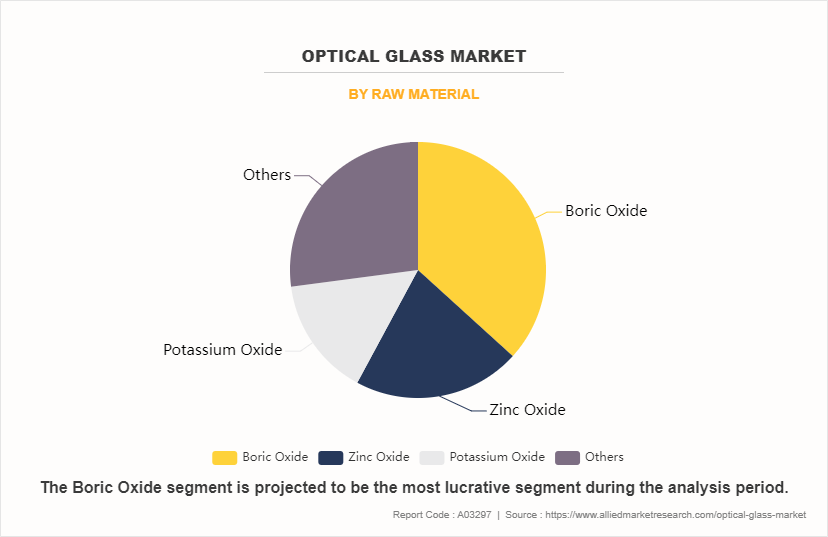
By raw material, the boric oxide sub-segment dominated the market in 2022. Boric oxide (B2O3), itself a glass former, acts as a flux (i.e., lowers the working temperature) when mixed with silica and forms borosilicate glass, and the substitution of small percentages of alkali and alumina increases the chemical stability. Boron trioxide (B2O3) is a chemical compound that can also be blended with silica to make borosilicate glass (often with some different additions like sodium oxide and aluminum oxide).
The BK7 glass, for instance, is a crown glass of such type. Boric oxide (B2O3), known as borates, is vital in optical glass manufacturing due to the fact it gives features that would be technically impossible or prohibitively high-priced to accomplish otherwise. It is utilized as a flux in optical glass manufacturing to lower processing temperatures in instances where alkali addition is restricted.
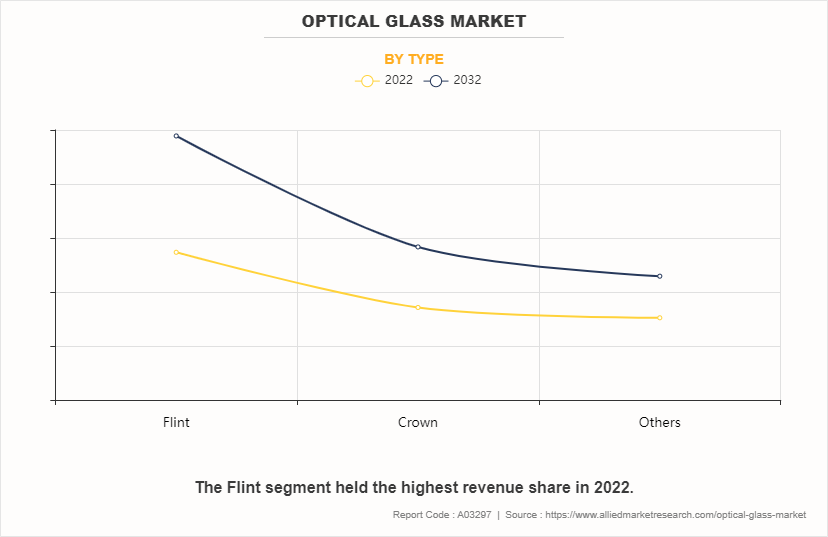
By type, the flint sub-segment dominated the global optical glass market share in 2022. Flint glasses have refractive indices ranging between 1.45 and 2.00. This property makes flint glass mainly ideal in the manufacturing of lenses, optical instruments, and prisms. Flint glasses have a significant role in advancing technologies such as augmented truth (AR), digital truth (VR), LiDAR (Light Detection and Ranging), and independent vehicles. These technologies require superior optics for imaging, sensing, and navigation, resulting in the demand for specialized glasses with specialized optical properties, which include flint glasses.
Furthermore, the demand for advanced optical systems and devices, such as high-resolution imaging systems, laser optics, and photonic devices, drives the need for high-resolution glasses with precise optical capabilities. Flint glasses are essential components in these superior optical systems, enabling the manipulation and control of light with excessive precision and accuracy.
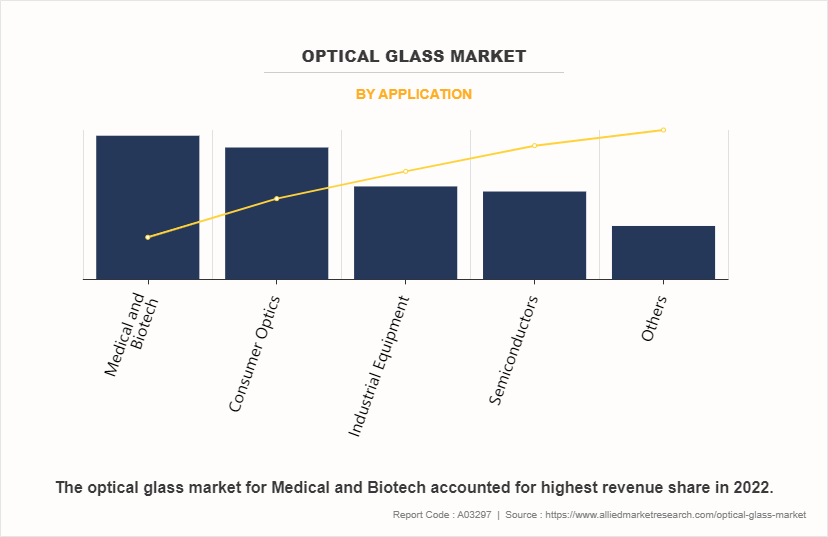
By application, the medical & biotech sub-segment dominated the global optical glass market share in 2022. Optical glass plays a crucial role in various medical and biotechnological applications due to its optical properties, including transparency, durability, and the ability to transmit light with minimal distortion. Optical glass is used in medical imaging devices such as endoscopes, microscopes, and imaging systems like MRI and CT scanners. These devices rely on high-quality optical components to capture and visualize images of internal body structures, aiding in diagnosis and treatment planning.
Optical glass is used in biomedical optics for applications such as fluorescence microscopy, flow cytometry, and laser-based therapies. These techniques enable researchers and clinicians to study cellular and molecular processes, diagnose diseases, and develop targeted treatments. Furthermore, increasing expenditure for surgeries is estimated to lead to an increase in consumption of optical glass for surgical tools. The increasing pharmaceutical industry is estimated to generate demand for scientific gadgets, which, in turn, is anticipated to increase the demand for optical glass in the upcoming years
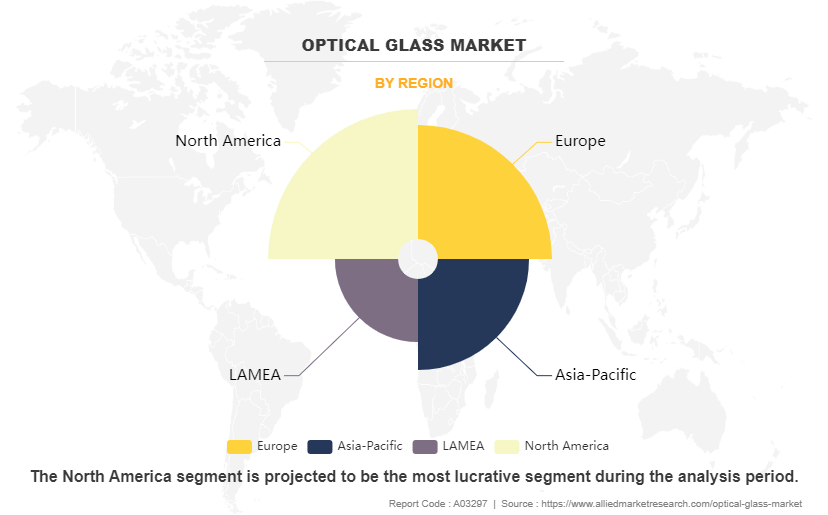
By region, North America dominated the global optical glass market in 2022. The region is known for its advanced technology and strong presence in industries such as telecommunications, healthcare, and defense, all of which rely heavily on optical glass for various applications including lenses, sensors, and fiber optics. In addition, North America is home to several key players in the optical glass industry, contributing to its dominance in the global market. SCHOTT North America, Inc. is a distinguished glass fabricator placed in Elmsford, New York, and operates as a division of Schott Corp.
With a strong focus on innovation and a wealth of expertise in glass manufacturing, SCHOTT North America specializes in an tremendous range of glass products, consisting of flat glass, wire glass, safety glass, heat-resistant glass, and textured glass. Their dedication to excellence has earned them a strong reputation as a leading manufacturer of glass fabrications, serving a variety of industries and markets.
Key Benefits For Stakeholders
- This report provides a quantitative analysis of the market segments, current trends, estimations, and dynamics of the optical glass market analysis from 2022 to 2032 to identify the prevailing optical glass market opportunities.
- The market research is offered along with information related to key drivers, restraints, and opportunities.
- Porter's five forces analysis highlights the potency of buyers and suppliers to enable stakeholders make profit-oriented business decisions and strengthen their supplier-buyer network.
- In-depth analysis of the optical glass market segmentation assists to determine the prevailing market opportunities.
- Major countries in each region are mapped according to their revenue contribution to the global market.
- Market player positioning facilitates benchmarking and provides a clear understanding of the present position of the market players.
- The report includes the analysis of the regional as well as global optical glass market trends, key players, market segments, application areas, and market growth strategies.
Optical Glass Market Report Highlights
| Aspects | Details |
| Market Size By 2032 | USD 2 billion |
| Growth Rate | CAGR of 5.7% |
| Forecast period | 2022 - 2032 |
| Report Pages | 319 |
| By Application |
|
| By Raw Material |
|
| By Type |
|
| By Region |
|
| Key Market Players | HOYA, Nikon Corporation, CARL Zeiss, OAG Werk Optik, CORNING, Schott, Edmund Optics, Crystran Ltd., Sumita Optical Glass, CDGM Glass Company |
The increasing penetration of smartphones, tablets, laptops, digital cameras, and other consumer electronics boosts the demand for optical glass components such as camera lenses, display panels, and fiber optics. The expanding middle-class population, rising disposable incomes, and technological advancements contribute to the growth of the consumer electronics industry globally. In addition, continuous advancements in optical glass manufacturing processes, materials, and design techniques drive innovation in the industry. These innovations lead to the development of high-performance optical components with improved clarity, durability, and precision, catering to diverse applications in various sectors such as consumer electronics, healthcare, aerospace, and automotive
The major growth strategies adopted by optical glass market players are investment and agreement.
Asia-Pacific is projected to provide more business opportunities for the global optical glass market in the future.
Schott, Hoya, Ohara Corporation, Edmund Optics, Crystran Ltd., Sterling Precision Optics, Sumita Optical Glass, CDGM Glass Company, Nikon Corporation, and Carl Zeiss are the major players in the optical glass market.
The flint sub-segment of the type segment acquired the maximum share of the global optical glass market in 2022.
Potential customers of the optical glass industry include manufacturers of consumer electronics, medical devices, and automotive components. In addition, telecommunications companies, aerospace & defense contractors, and industrial instrumentation manufacturers are also significant customers for optical glass products. These industries rely on optical glass for various applications such as camera lenses, sensors, fiber optics, and optical components in their respective products and systems.
The report provides an extensive qualitative and quantitative analysis of the current trends and future estimations of the global optical glass market from 2022 to 2032 to determine the prevailing opportunities.
The increasing demand for high-resolution cameras, advanced display technologies, and augmented reality (AR) devices in smartphones, tablets, laptops, and digital cameras is expected to drive the adoption of optical glass components such as camera lenses, display panels, and sensors. The expansion of medical imaging technologies, including MRI machines, CT scanners, endoscopes, and surgical microscopes, is anticipated to drive the demand for optical glass lenses, prisms, and optical fibers used in medical devices for diagnosis, treatment, and surgical procedures.
Loading Table Of Content...
Loading Research Methodology...


